Reading time: 13 min
A King had a daughter who was beautiful beyond all measure, but so proud and haughty withal that no suitor was good enough for her. She sent away one after the other, and ridiculed them as well. Once the King made a great feast and invited thereto, from far and near, all the young men likely to marry. They were all marshalled in a row according to their rank and standing. First came the kings, then the grand-dukes, then the princes, the earls, the barons, and the gentry. Then the King’s daughter was led through the ranks, but to every one she had some objection to make. One was too fat, „The wine-cask,“ she said.
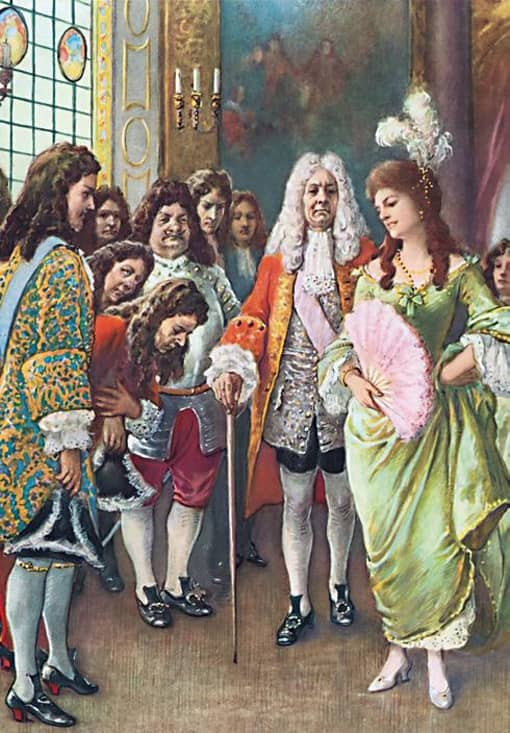 Image: Oskar Herrfurth (1862-1934)
Image: Oskar Herrfurth (1862-1934)Another was too tall, „Long and thin has little in.“ The third was too short, „Short and thick is never quick.“ The fourth was too pale, „As pale as death.“ The fifth too red, „A fighting-cock.“ The sixth was not straight enough, „A green log dried behind the stove.“ So she had something to say against every one, but she made herself especially merry over a good king who stood quite high up in the row, and whose chin had grown a little crooked. „Well,“ she cried and laughed, „he has a chin like a thrush’s beak!“ and from that time he got the name of King Thrushbeard.
But the old King, when he saw that his daugher did nothing but mock the people, and despised all the suitors who were gathered there, was very angry, and swore that she should have for her husband the very first beggar that came to his doors. A few days afterwards a fiddler came and sang beneath the windows, trying to earn a small alms. When the King heard him he said, „Let him come up.“ So the fiddler came in, in his dirty, ragged clothes, and sang before the King and his daughter, and when he had ended he asked for a trifling gift. The King said, „Your song has pleased me so well that I will give you my daughter there, to wife.“
The King’s daughter shuddered, but the King said, „I have taken an oath to give you to the very first beggar-man, and I will keep it.“ All she could say was in vain. The priest was brought, and she had to let herself be wedded to the fiddler on the spot. When that was done the King said, „Now it is not proper for you, a beggar-woman, to stay any longer in my palace, you may just go away with your husband.“ The beggar-man led her out by the hand, and she was obliged to walk away on foot with him.
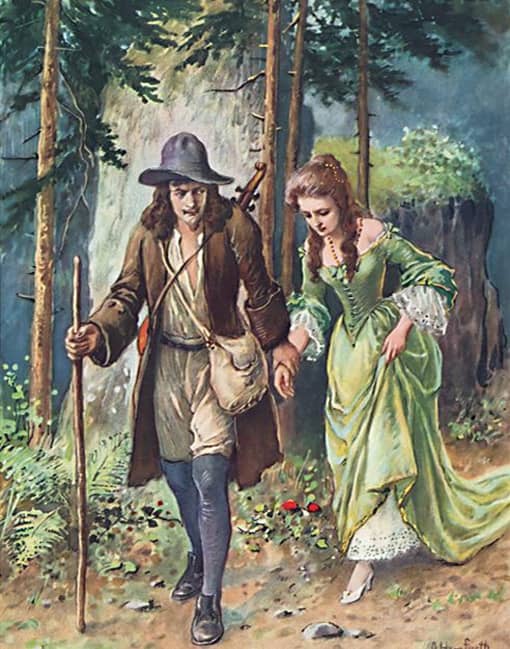 Image: Oskar Herrfurth (1862-1934)
Image: Oskar Herrfurth (1862-1934)When they came to a large forest she asked, „To whom does that beautiful forest belong?“ – „It belongs to King Thrushbeard. If you had taken him, it would have been yours.“ – „Ah, unhappy girl that I am, if I had but taken King Thrushbeard!“ Afterwards they came to a meadow, and she asked again, „To whom does this beautiful green meadow belong?“ – „It belongs to King Thrushbeard. If you had taken him, it would have been yours.“ – „Ah, unhappy girl that I am, if I had but taken King Thrushbeard!“
Then they came to a large town, and she asked again, „To whom does this fine large town belong?“ – „It belongs to King Thrushbeard. If you had taken him, it would have been yours.“ – „Ah, unhappy girl that I am, if I had but taken King Thrushbeard!“ – „It does not please me,“ said the fiddler, „to hear you always wishing for another husband. Am I not good enough for you?“ At last they came to a very little hut, and she said, „Oh goodness! What a small house. To whom does this miserable, mean hovel belong?“ The fiddler answered, „That is my house and yours, where we shall live together.“
She had to stoop in order to go in at the low door. „Where are the servants?“ said the King’s daughter. „What servants?“ answered the beggar-man. „You must yourself do what you wish to have done. Just make a fire at once, and set on water to cook my supper, I am quite tired.“ But the King’s daughter knew nothing about lighting fires or cooking, and the beggar-man had to lend a hand himself to get anything fairly done. When they had finished their scanty meal they went to bed. But he forced her to get up quite early in the morning in order to look after the house.
For a few days they lived in this way as well as might be, and came to the end of all their provisions. Then the man said, „Wife, we cannot go on any longer eating and drinking here and earning nothing. You weave baskets.“ He went out, cut some willows, and brought them home. Then she began to weave, but the tough willows wounded her delicate hands.
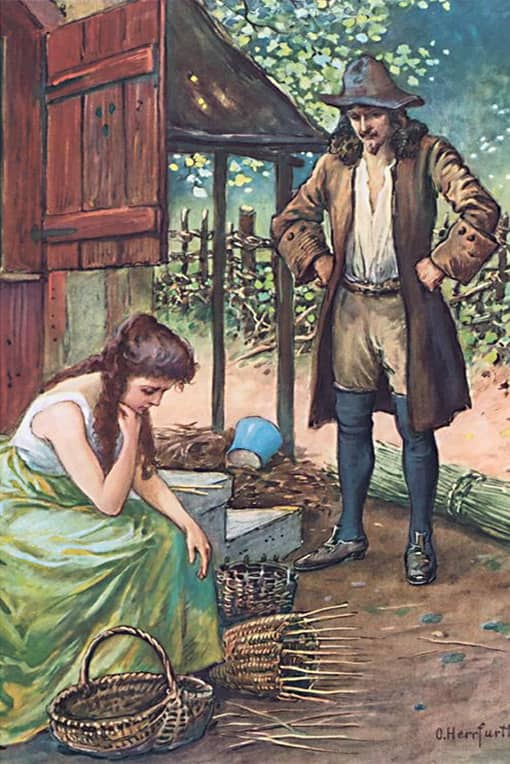 Image: Oskar Herrfurth (1862-1934)
Image: Oskar Herrfurth (1862-1934)„I see that this will not do,“ said the man. „You had better spin, perhaps you can do that better.“ She sat down and tried to spin, but the hard thread soon cut her soft fingers so that the blood ran down. „See,“ said the man, „you are fit for no sort of work. I have made a bad bargain with you. Now I will try to make a business with pots and earthenware. You must sit in the market-place and sell the ware.“ – „Alas,“ thought she, „if any of the people from my father’s kingdom come to the market and see me sitting there, selling, how they will mock me?“
But it was of no use, she had to yield unless she chose to die of hunger. For the first time she succeeded well, for the people were glad to buy the woman’s wares because she was good-looking, and they paid her what she asked. Many even gave her the money and left the pots with her as well. So they lived on what she had earned as long as it lasted, then the husband bought a lot of new crockery. With this she sat down at the corner of the market-place, and set it out round about her ready for sale. But suddenly there came a drunken hussar galloping along, and he rode right amongst the pots so that they were all broken into a thousand bits.
She began to weep, and did now know what to do for fear. „Alas! what will happen to me?“ cried she. „What will my husband say to this?“ She ran home and told him of the misfortune. „Who would seat herself at a corner of the market-place with crockery?“ said the man. „Leave off crying, I see very well that you cannot do any ordinary work, so I have been to our King’s palace and have asked whether they cannot find a place for a kitchen-maid, and they have promised me to take you. In that way you will get your food for nothing.“
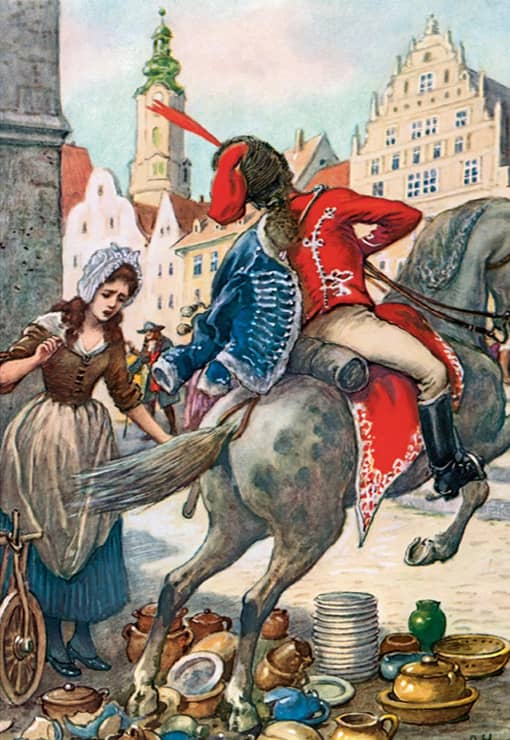 Image: Oskar Herrfurth (1862-1934)
Image: Oskar Herrfurth (1862-1934)The King’s daughter was now a kitchen-maid, and had to be at the cook’s beck and call, and do the dirtiest work. In both her pockets she fastened a little jar, in which she took home her share of the leavings, and upon this they lived. It happened that the wedding of the King’s eldest son was to be celebrated, so the poor woman went up and placed herself by the door of the hall to look on. When all the candles were lit, and people, each more beautiful than the other, entered, and all was full of pomp and splendour, she thought of her lot with a sad heart, and cursed the pride and haughtiness which had humbled her and brought her to so great poverty.
The smell of the delicious dishes which were being taken in and out reached her, and now and then the servants threw her a few morsels of them: these she put in her jars to take home. All at once the King’s son entered, clothed in velvet and silk, with gold chains about his neck. And when he saw the beautiful woman standing by the door he seized her by the hand, and would have danced with her. But she refused and shrank with fear, for she saw that it was King Thrushbeard, her suitor whom she had driven away with scorn.
Her struggles were of no avail, he drew her into the hall. But the string by which her pockets were hung broke, the pots fell down, the soup ran out, and the scraps were scattered all about. And when the people saw it, there arose general laughter and derision, and she was so ashamed that she would rather have been a thousand fathoms below the ground. She sprang to the door and would have run away, but on the stairs a man caught her and brought her back. And when she looked at him it was King Thrushbeard again.
He said to her kindly, „Do not be afraid, I and the fiddler who has been living with you in that wretched hovel are one. For love of you I disguised myself so. And I also was the hussar who rode through your crockery. This was all done to humble your proud spirit, and to punish you for the insolence with which you mocked me.“ Then she wept bitterly and said, „I have done great wrong, and am not worthy to be your wife.“ But he said, „Be comforted, the evil days are past. Now we will celebrate our wedding.“ Then the maids-in-waiting came and put on her the most splendid clothing, and her father and his whole court came and wished her happiness in her marriage with King Thrushbeard, and the joy now began in earnest. I wish you and I had been there too.
 Learn languages. Double-tap on a word.Learn languages in context with Childstories.org and Deepl.com.
Learn languages. Double-tap on a word.Learn languages in context with Childstories.org and Deepl.com.Backgrounds
Interpretations
Adaptions
Summary
Abstract
Linguistics
„King Thrushbeard“ is a classic fairy tale collected by the Brothers Grimm in their famous compilation „Grimms‘ Fairy Tales“ (Kinder- und Hausmärchen). The story was first published in 1815 as part of the first edition of the collection and is known as tale number 52. Like many other fairy tales, „King Thrushbeard“ has its roots in European oral tradition and is a reflection of the values and beliefs of the society during that time.
The story revolves around a proud and haughty princess who is known for her great beauty but also her disdainful attitude towards her suitors. Her father, the King, is eager to find her a suitable husband, but she rejects them all, ridiculing their appearances and giving each of them unkind nicknames. One of these suitors is a handsome young king, whom she derisively calls „King Thrushbeard“ due to his slightly hooked nose. Exasperated by her behavior, the King decides to marry her off to the first beggar that comes to the castle. As a result, the princess is forced to leave her privileged life behind and live in poverty. She eventually learns humility, kindness, and the value of hard work. In the end, it is revealed that the beggar she married is actually King Thrushbeard in disguise, who arranged the entire ordeal to teach her a lesson.
The fairy tale reflects some common themes of the era, such as the importance of humility and the moral transformation of the protagonist. In „King Thrushbeard,“ the proud and arrogant princess must learn the hard way that her unkind behavior has consequences, and that true happiness comes from inner virtue rather than superficial appearances. Additionally, the story’s emphasis on the princess’s growth and transformation through difficult circumstances can be seen as an allegory for the process of self-discovery and self-improvement that was highly valued in the Romantic era, when the Brothers Grimm collected and published their tales.
The Brothers Grimm, Jacob and Wilhelm Grimm, were German academics, linguists, and cultural researchers who collected and published folklore during the 19th century. Their collection of fairy tales has become an essential part of Western literature and popular culture, and their work has significantly influenced our understanding of folktales and storytelling traditions. The story of „King Thrushbeard“ belongs to the Aarne-Thompson-Uther (ATU) classification system under type 900, „The Princess Who Despised All of Her Suitors.“ This type of story revolves around a proud and haughty princess who rejects her suitors, only to later experience a change of heart and learn humility through various trials and tribulations. Similar tales can be found in different cultures and folklore traditions across the world.
The setting of the tale is a typical medieval European kingdom, with a royal court, feasts, and noble suitors from different regions. The story reflects the societal expectations of the time, including the importance of social status, marriage, and obedience to one’s parents. It also highlights values such as humility, empathy, and personal growth.Overall, „King Thrushbeard“ serves as a timeless reminder of the importance of humility, kindness, and compassion, as well as a reflection of the cultural and historical context in which it was first recorded.
„King Thrushbeard“ is a fairy tale that lends itself to multiple interpretations. As with many other fairy tales, readers and scholars can derive various lessons and insights from this story, which may resonate differently with individuals depending on their own experiences and perspectives. Some common interpretations of „King Thrushbeard“ include.
The importance of humility: One of the most prominent themes in the story is the lesson of humility. The princess’s arrogance and pride lead to her eventual downfall, and she must learn to treat others with kindness and respect. The tale serves as a cautionary reminder that pride can have negative consequences and that true beauty lies in one’s character, not their physical appearance.
The role of women in society: As a fairy tale from the 19th century, „King Thrushbeard“ reflects the patriarchal values of its time. The princess is punished for her independence and assertiveness, and her transformation is ultimately brought about by her submission to her husband. This interpretation can lead to discussions about gender roles, expectations, and the ways in which women’s agency was limited in traditional societies.
Overcoming pride and arrogance: The primary theme of the story is the transformation of the princess from a proud and haughty individual to a humble and repentant person. The experiences she goes through help her realize the importance of humility and kindness. This interpretation highlights the message that pride and arrogance can lead to suffering, while humility brings happiness.
The importance of empathy and understanding: Throughout the story, the princess learns to empathize with people from different walks of life. She comes to understand the struggles of ordinary people, which helps her become more compassionate and empathetic. This interpretation emphasizes the need for empathy and understanding in our interactions with others. Despite the princess’s initially cruel treatment of King Thrushbeard and her other suitors, the story ultimately ends with forgiveness and redemption. King Thrushbeard forgives the princess for her past actions, and she is given a chance to grow and become a better person. This interpretation emphasizes the importance of forgiveness and the possibility of redemption for those who have made mistakes.
Love and redemption: King Thrushbeard’s love for the princess is a significant aspect of the story. His actions, though seemingly harsh, are driven by his desire to help her become a better person. In the end, his love leads to the princess’s redemption, and they are united in a loving marriage. This interpretation highlights the power of love to bring about personal growth and positive change. King Thrushbeard’s love for the princess is the driving force behind his decision to teach her a lesson in humility. His love for her is deep and genuine, and he believes that helping her become a better person is the greatest gift he can give her. This interpretation highlights the power of love to change people for the better.
The danger of making hasty judgments: The princess’s initial rejection of her suitors, including King Thrushbeard, is based on superficial judgments. Her experiences teach her the importance of looking beyond appearances and being more thoughtful in her judgments. This interpretation serves as a reminder not to judge others solely based on their looks or social status.
The value of hard work: The princess’s struggles in her new life teach her the importance of hard work and perseverance. She learns to appreciate the efforts of those who work to make a living and realizes that success often comes from resilience and determination. This interpretation underscores the importance of work ethic and determination in overcoming life’s challenges. The princess’s journey from a life of privilege to one of poverty serves as a commentary on the value of hard work and the struggles faced by those in lower social classes. By experiencing life as a commoner, the princess learns to appreciate the challenges and rewards of labor and the importance of treating people with dignity and respect, regardless of their social standing.
These interpretations of „King Thrushbeard“ are just a few of the many ways in which the story can be read and analyzed. Ultimately, the fairy tale serves as a rich source of discussion and reflection, allowing readers to explore various themes and lessons that continue to resonate in modern times.
„King Thrushbeard“ is a German fairy tale collected by the Brothers Grimm in their famous compilation, „Grimms‘ Fairy Tales“ (originally titled „Kinder- und Hausmärchen“), first published in 1812. The tale has been adapted in various forms over the years, including film, television, literature, and theater. These adaptations often take creative liberties with the original tale, adding new elements or reinterpreting the story to suit a specific audience or medium. Some examples of adaptations of „King Thrushbeard“ include.
Films: „König Drosselbart“ (1954) This East German film, directed by Walter Beck, is a live-action adaptation of the fairy tale. The film remains faithful to the original story and is notable for its lavish set design and costumes, which bring the world of the fairy tale to life on screen. „The Princess and the Beggar,“ a 1930 short film directed by Walter Lantz and Bill Nolan, is an animated adaptation of „King Thrushbeard.“ The film was part of the Oswald the Lucky Rabbit series, and features Oswald as the beggar who marries the princess.
Television: „Grimm’s Fairy Tale Classics“ (1988) The animated television series „Grimm’s Fairy Tale Classics“ (also known as „Grimm Masterpiece Theater“) featured an adaptation of „King Thrushbeard“ in an episode titled „King Grizzlebeard.“ The episode follows the original story closely, with some modifications for the sake of brevity and to suit a younger audience. „King Thrushbeard,“ a 1984 episode of the animated television series Faerie Tale Theater, features Shelly Duvall as the princess and Christopher Reeve as King Thrushbeard. The episode follows the original story closely, but adds some humorous touches and a happy ending.
Theater: „König Drosselbart“ (2009) A theatrical adaptation of „King Thrushbeard“ was performed by the Theater Erfurt in Germany. This family-friendly musical production included original songs and dance numbers, bringing a fresh take on the classic tale.
Opera: „King Thrushbeard,“ a 1955 opera by Czech composer Bohuslav Martinů, is based on the fairy tale. The opera premiered in Germany and has since been performed in many countries around the world.
Picture Books: „King Thrushbeard“ by Doris Orgel (1994) Doris Orgel’s illustrated adaptation of the fairy tale is aimed at young readers. The book retells the story of „King Thrushbeard“ with engaging illustrations, simplifying some of the original text to make it more accessible for children. „The King Who Thought He Was Clever,“ a children’s book by Hungarian author Dénes Krusovszky, is a modern retelling of „King Thrushbeard.“ The book features humorous illustrations and a clever twist on the original story.
Literature: „Wise Women: Folk and Fairy Tales from Around the World“ by Suzannah Reiss (1997) This collection of folk and fairy tales includes a version of „King Thrushbeard“ retold by Suzannah Reiss. The story is presented alongside other tales featuring strong female protagonists, encouraging readers to explore the diverse range of women’s experiences and stories within the world of fairy tales. „Thorn,“ a 2012 young adult novel by Intisar Khanani, is a retelling of „King Thrushbeard“ set in a fantasy world. The novel features a strong-willed princess who must marry a commoner to save her kingdom, and explores themes of class, identity, and self-discovery.
There have been many adaptations of the fairy tale „King Thrushbeard“ from the Brothers Grimm collection over the years. These adaptations demonstrate the enduring appeal of „King Thrushbeard“ and its themes, and how the story can be reimagined in various forms to entertain and engage audiences of all ages.
„King Thrushbeard“ is a fairy tale by the Brothers Grimm about a proud and haughty princess who learns humility, kindness, and the value of hard work through a series of trials. The story begins with the princess rejecting all of her suitors, ridiculing them for their appearances. One suitor, a handsome young king with a slightly hooked nose, earns the nickname „King Thrushbeard“ from the princess. Frustrated with her behavior, the King, her father, decides to marry her off to the first beggar who comes to the castle.
A poor musician arrives at the castle, and the King declares that the princess must marry him. Stripped of her royal status and possessions, the princess is forced to live a life of poverty with her new husband. She struggles to adapt to her new circumstances, learning to cook, clean, and work in the fields. Eventually, the princess finds work in a nearby castle, where she accidentally breaks a valuable dish. In order to pay for the damage, she is sent to work as a kitchen maid. Through these experiences, the princess learns humility, kindness, and the importance of hard work.
One day, a grand feast is held at the castle, and the princess is allowed to attend. To her surprise, she discovers that her husband, the beggar, is none other than King Thrushbeard, who had disguised himself to teach her a valuable lesson. Having recognized her faults and transformed her character, the princess is reunited with her true husband, and they live happily ever after. „King Thrushbeard“ is a tale of personal growth, transformation, and the importance of inner virtues, serving as a reminder of the value of humility and kindness in one’s character.
„King Thrushbeard“ is a fairy tale by Brothers Grimm about a beautiful but proud and haughty princess who rejects all her suitors. Her father, the King, becomes angry and decides that she will marry the first beggar who comes to his palace. Soon after, a fiddler arrives, and the King gives his daughter in marriage to him.
The newlyweds live in a small hut, and the princess learns how hard life can be. She regrets not marrying King Thrushbeard, a suitor she mocked due to his crooked chin. Her husband tries to help her learn various tasks, but she fails at each one. Eventually, she becomes a kitchen-maid at the palace of King Thrushbeard.
During a royal wedding, the princess is recognized by King Thrushbeard, who reveals himself as her husband, the fiddler, and the hussar who broke her crockery. He tells her that he disguised himself to teach her humility and punish her for her insolence. The princess acknowledges her wrongdoings, and they celebrate their wedding with her father’s blessings. The story ends with happiness and joy, leaving the reader to wish they had been present at the celebration.
The fairy tale „King Thrushbeard“ by the Brothers Grimm offers rich material for linguistic analysis, showcasing the use of language to convey themes of pride, humility, transformation, and social norms. Here are some aspects that may be considered in a linguistic analysis:
Characterization through Dialogue: The princess is characterized as haughty and scornful through her sharp and mocking dialogue. Her use of pejorative nicknames for her suitors („wine-cask,“ „fighting-cock,“ „King Thrushbeard“) highlights her disdain and arrogance. In contrast, King Thrushbeard’s language is gentle and understanding by the story’s end, reflecting his forgiving nature and the lesson he intended to impart.
Repetition: Repetition is used effectively to emphasize the princess’s regret. The refrain „If I had but taken King Thrushbeard!“ underscores her growing remorse and realization of her past mistakes. This linguistic device also reinforces the theme of lost opportunity and the consequences of pride.
Use of Imagery: Vivid imagery is employed to create contrasts between wealth and poverty, pride and humility. The opulence of King Thrushbeard’s possessions (his forest, meadows, town) and the humble conditions the princess endures with the beggar provide stark visual contrasts that represent her fall from grace.
Transitional Language: The narrative uses transitional language to indicate shifts in the princess’s circumstances and emotions. Phrases like „Ah, unhappy girl that I am“ mark her transition from arrogance to regret, allowing readers to track her emotional journey.
Symbolism in Names: The name „King Thrushbeard“ itself is symbolic. The comparison of his chin to a thrush’s beak is initially used by the princess to mock him, but it becomes emblematic of her lack of judgment and superficiality. As the story progresses, King Thrushbeard’s identity as a noble character becomes more significant than his physical appearance, symbolizing the inner qualities of humility, patience, and love.
Moral and Didactic Elements: The tale’s language serves a didactic purpose, teaching a moral lesson about the perils of pride and the value of humility. The use of direct speech in moments of instruction or revelation („Do not be afraid. . . „) serves to articulate the story’s moral directly to the audience.
Social hierarchies and norms: The story uses language to reflect societal norms and class systems. The hierarchical organization of suitors (kings, grand-dukes, princes, etc. ) and the father’s authority over his daughter highlight the social structures of the time. The princess’s transformation from a royal to a beggar’s wife further explores themes of social mobility and the arbitrariness of status.
Overall, „King Thrushbeard“ utilizes language not just to entertain, but to explore complex themes of character development, societal norms, and moral values. Through dialogue, symbolism, and narrative structure, the Brothers Grimm create a story that resonates with cultural and ethical significance.
Information for scientific analysis
Fairy tale statistics | Value |
|---|---|
| Number | KHM 52 |
| Aarne-Thompson-Uther-Index | ATU Typ 900 |
| Translations | DE, EN, DA, ES, PT, FI, HU, IT, JA, NL, PL, RO, RU, TR, VI, ZH |
| Readability Index by Björnsson | 26.9 |
| Flesch-Reading-Ease Index | 86.4 |
| Flesch–Kincaid Grade-Level | 5.2 |
| Gunning Fog Index | 7.8 |
| Coleman–Liau Index | 7.5 |
| SMOG Index | 7.6 |
| Automated Readability Index | 5.2 |
| Character Count | 8.619 |
| Letter Count | 6.552 |
| Sentence Count | 104 |
| Word Count | 1.657 |
| Average Words per Sentence | 15,93 |
| Words with more than 6 letters | 181 |
| Percentage of long words | 10.9% |
| Number of Syllables | 2.042 |
| Average Syllables per Word | 1,23 |
| Words with three Syllables | 59 |
| Percentage Words with three Syllables | 3.6% |
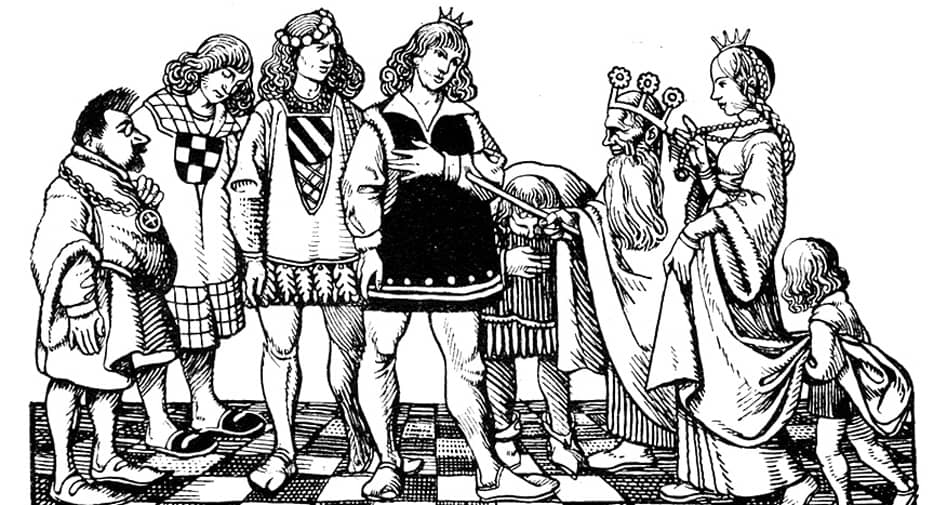
 Facebook
Facebook  Whatsapp
Whatsapp  Messenger
Messenger  Telegram
Telegram Reddit
Reddit















